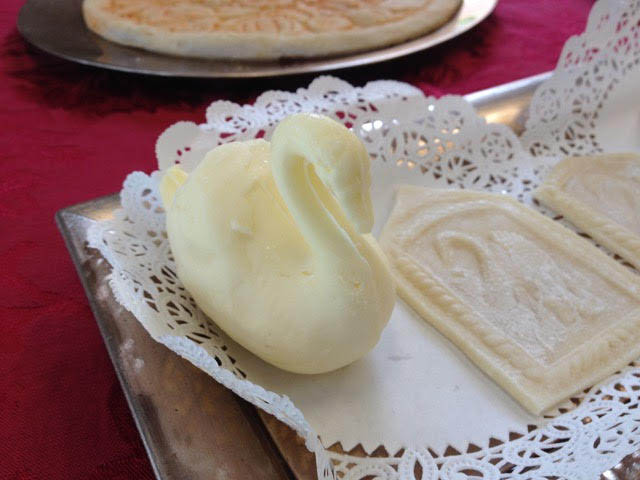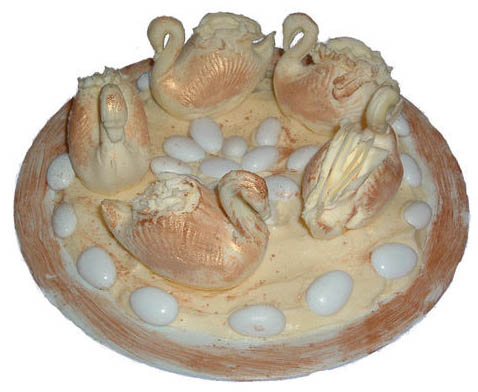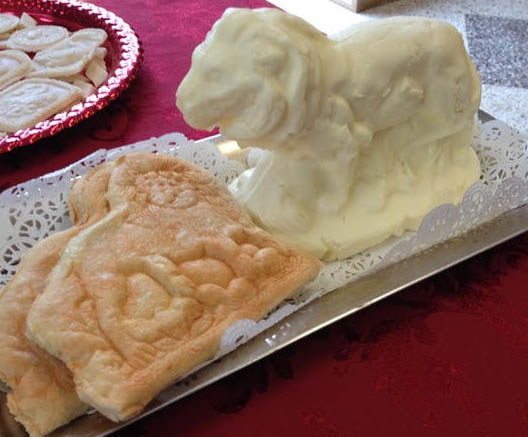Known World Spotlight
Butter Sculptures
By THL Johnnae llyn Lewis, CE
Butter poses interesting problems for Society feasts. What can be done with butter that makes it more interesting? Might I suggest the art of butter sculpting or butter molding?
Quite possibly the earliest documented instances of butter sculpting can be found in far off Tibet where devout Buddhists still fashion colored yak butter into flowers, animals, symbols, or auspicious devotional figures. These figures are known as torma and are said to date from as early as the fifteenth century. The origins are somewhat in dispute, and there are a number of myths or stories as to how or why the tradition began. Sources point out that traditionally older sculptures are broken apart, and the butter reused; there are no surviving ancient sculptures. The practice is associated with the Tibetan New Year or Losar which occurs in February or March. One of the highlights of Losar is the lighting of thousands of butter lanterns or butter lamps.
In Renaissance Europe, the great Italian mastercook Bartolomeo Scappi offers a tantalizing introduction to the subject of butter sculptures in Europe. In 1536 he created a banquet for the last day of May to be served in a garden. The first service began with “statue di zuccaro” or sugarworks. The third course featured pastry sculptures. Of most interest to readers here is the second course which began with “con le altre sei statue di butiro.” These butter sculptures included: “Uno Elephante con un castello su laschena,” “Hercole che sbranava la bocca al lione,” “Il gran villano de Campidoglio,” “Un Camello, con un Re moro sopra,” and “Un’alicorno che habbia il corno in bocca al serpente.” Scappi’s butter sculptures have been featured of late in many accounts, including Wikipedia’s entry on “butter sculptures”.(Opera, p.398)
A lesser known but perhaps even more interesting source for butter sculptures can be found in the work Le Ouverture de Cuisine. In 1604, Lancelot du Casteau published in the city of Liege the small cookery book titled Le Ouverture de Cuisine. The work has been recently translated by Master Edouard Halidai/Daniel Myers. Le Ouverture ends with the description of butter sculptures created for the banquet “of Monsieur Robert de Berges Count of Walhain, Esquire & Prince of Liege, made in the palace in Liege, the year 1557 in the month of December.” The list reads:
“There were four parks of two feet square, environed in a hedge of butter.
The first was Adam & Eve made of butter, a serpent on a tree, & a running fountain, with little animals all around of butter.
The second park was the love of Pyramus & Thisbee, the lion by the fountain, & the trees all around environed in a hedge of butter.
The third park the hunt of Acteon, & the nymphs with Diana at the fountain, & then of the little dogs of butter.
The fourth park was two wild men, who battled one another with the masses by a fountain, & little lions of butter all around: each park had four banners.” (Myers)
So based upon these descriptions from Scappi and Le Ouverture, it seems that for special feasts in at least the spring and winter months, we can and ought to be creating sculptures of butter or diverse and lovely objects and animals of butter.
Creating the Butter Sculpture or Molded Figures
Having grown up with parents and grandparents that owned and milked dairy cows, I have some background in dairies, butter making, and molding. I can’t recommend that one start with a cow and work one’s way up through churning and then into molding butter, except as a demonstration project. Given the cost of numerous subtletie materials such as almond paste or sugar paste made with gun tracaganth, butter is a relative bargain. I often pay less than $2.00 USD per pound. The trick is to buy when it’s on sale and freeze it for use as needed. It’s certainly much cheaper to work with butter than marzipan or sugarpaste, and butter for most feasts is already a budgeted and necessary item.
Both John Murrell and Hugh Plat mention cutters and moulds of tinne being used in the late 16th and early 17th century English kitchen. Today there are a number of commercial butter molds which can be purchased. Flat carved butter stamps are quite common. Often made out of wood or ceramics these stamps impress or print a design on a butter circle or square. It would be possible to create kingdom or baronial arms in a carving and imprint the arms in butter. (Once made, uses could also extend to cookies or other items.) Small butter molding can be done using flexible rubber butter molds or flat plastic candy molds. They can be found in a variety of seasonal themes or as designs like suns, moons, flowers, etc. Instructions call for filling the molds with softened butter. Freeze until hard. Carefully pop out the molded butters and freeze until needed.
More complicated and expensive are the commercial food safe 3-D plastic molds. These two or three part molds enable one to make 3-D statues of butter. Provided that one can find the mold, one can make cows, horses, deer, elephants, swans, lions, tigers, bears, etc. Be sure to check measurements carefully as many hobbyists have entered the market and are selling rather small home 3-D printed items. My personal preference are the professional weight molds such as those sold by Tomric. When doing butter and honey butter sculptures for feasts, it’s perhaps best to order multiples and in different sizes. http://www.tomric.com/ Tomric molds can be expensive; there is also a minimum order size. Also the molds must be ordered well in advance as some designs come from Europe. (These molds can be used also for molding chocolate, should that fact influence and make their purchase more attractive.)
I would add that butter molding is not as easy as it first looks. It can take a great deal of time to mold multiples of even small animals or objects in butter for a feast. I do use food safe non latex gloves when handling butter for feasts. The finished items do keep and if wrapped well and stored in plastic boxes, the butter figures can be made in advance and stored in a freezer until needed. Finished sculptures can be decorated with food safe color dusts or garnished with flower petals. (I won’t go into the opinions pro and con or the history of honey butter in this article, but will note that it’s long been a traditional item on Society tables and is still requested to this day.) Honey butter molding is trickier as the honey has a tendency to weep out if the proportions of honey to butter are incorrect. Use too much honey and the figure will weep honey. Use too little and the figure won’t taste of honey. It’s tricky. But as butter is relatively inexpensive to buy, I would urge more people to take up the craft of butter molding. Butter sculpture where one starts out with a block of butter and sculpts the figure from scratch calls for the same skills as needed in artistic sculpture of other materials, with the added need for working in a cold environment.
Lastly as someone born and raised in Midrealm (Illinois, Land of Lincoln and downstate farms), one must mention the famous life size “butter cows” of our summer state fairs. For those interested in “butter cows” there are a number of articles and photos, (plus streaming video, and live webcams during the actual fairs) which may be found online. Search under “Butter cows.” Generally, they are sculpted over an elaborate framework of wire mesh, steel, and wood. Iowa uses about 600 pounds of butter for each life size cow. (The donated dairy butter is often recycled and reused by food banks or even converted into biodiesel fuel.) Illinois’s butter cows often decorate the fair posters. North Carolina used a reported 1200 pounds in their sculpture in 2000. It took ten days to sculpt. Butter people, butter celebrities, butter buildings, popular culture, including Harry Potter and Star Trek, as well as the cows and calves, are all explored in the Pamela Simpson article and book cited below.
Sources
| The Opera of Bartolomeo Scappi (1570). Translated by Terence Scully. Toronto: University of Toronto Press, 2008. |
| Le Ouverture de Cuisine . 1604. This rough translation is courtesy of Daniel Myers (copyright 2006) at http://www.medievalcookery.com/notes/ouverture.shtm The butter descriptions are located just prior to the book’s index. {It should be noted that while the book was initially published in 1604, it was actually written in circa 1585 or a generation earlier than the first publication. See Terence Scully’s 2006 volume titled La Varenne’s Cookery for details as to this dating.} A French transcription based on the 1983 facsimile of the original text may be found on Professor Thomas Gloning’s website. See p 153 for the butter sculptures. https://www.uni-giessen.de/fbz/fb05/germanistik/absprache/sprachverwendung/gloning/tx/ouv3.htm |
| “Butter Sculpture.” Wikipedia, Wikimedia Foundation, 25 Mar. 2021, en.wikipedia.org/wiki/Butter_sculpture. Danovich, Tove. “A Toast To Butter Sculpture, The Art That Melts The Hearts Of The Masses.” NPR, NPR, 25 June 2015, www.npr.org/sections/thesalt/2015/06/25/413706612/a-toast-to-butter-sculpture-the-art-that-melts-the-hearts-of-the-masses |
| Ewbank, Anne. “Tibetan Buddhist Butter Sculptures.” Atlas Obscura, Atlas Obscura, 19 Oct. 2018, www.atlasobscura.com/foods/tibetan-butter-sculptures. |
| Giaimo, Cara. “America’s First Butter Sculptor Was an Artist and a Celebrity.” Atlas Obscura, Atlas Obscura, 14 Nov. 2017, www.atlasobscura.com/articles/caroline-shawk-brooks-butter-sculptor-history. |
| Kunga. “Tibetan Butter Sculpture – An Ancient Form of Tibetan Art.” Tibet Travel Blog, Tibet Vista (Tibettravel.org), 2 June 2017, tinyurl.com/kdf66cuc |
| Levitt, Aimee. “The Surprisingly Lofty History of American Butter Sculpting.” The Takeout, G/O Media, 10 Jan. 2018, thetakeout.com/the-surprisingly-lofty-history-of-american-butter-sculp-1821827196. |
| Russeth, Andrew. “Fat of the Land: A Look at the Iowa State Fair’s Butter Sculptures, From FDR to Garth Brooks.” ARTnews.com, ARTnews.com, 18 Nov. 2019, www.artnews.com/art-news/news/butter-sculptures-iowa-state-fair-13125/. Great photos! |
| Simpson, Pamela H. “Butter Cows and Butter Buildings. A History of an Unconventional Sculptural Medium.” Winterthur Portfolio. 2007. 41:1. Web. http://panam1901.org/agriculture/articles/winterthur_butter_sculpture.pdf |
| Simpson, Pamela H. Corn Palaces and Butter Queens: A History of Crop Art and Dairy Sculpture. Minneapolis: University of Minnesota Press, 2012. |
| “Tibetan Butter Sculpture – The Most Unique Artform of Tibet.” Explore Tibet, 26 July 2018, www.exploretibet.com/blog/tibetan-butter-sculpture-the-most-unique-artform-of-tibet/. |
| White, April. “The Decadent Art of Butter Sculpture.” JSOR Daily, JSTOR, 19 May 2017, daily.jstor.org/the-decadent-art-of-butter-sculpture/. |
| Zuras, Matthew. “The History of Butter Sculpyure is Strange, Indeed.” Vice. Web, 10 Aug 2014 https://www.vice.com/en/article/mgxzvx/the-history-of-butter-sculpture-is-strange-in |



